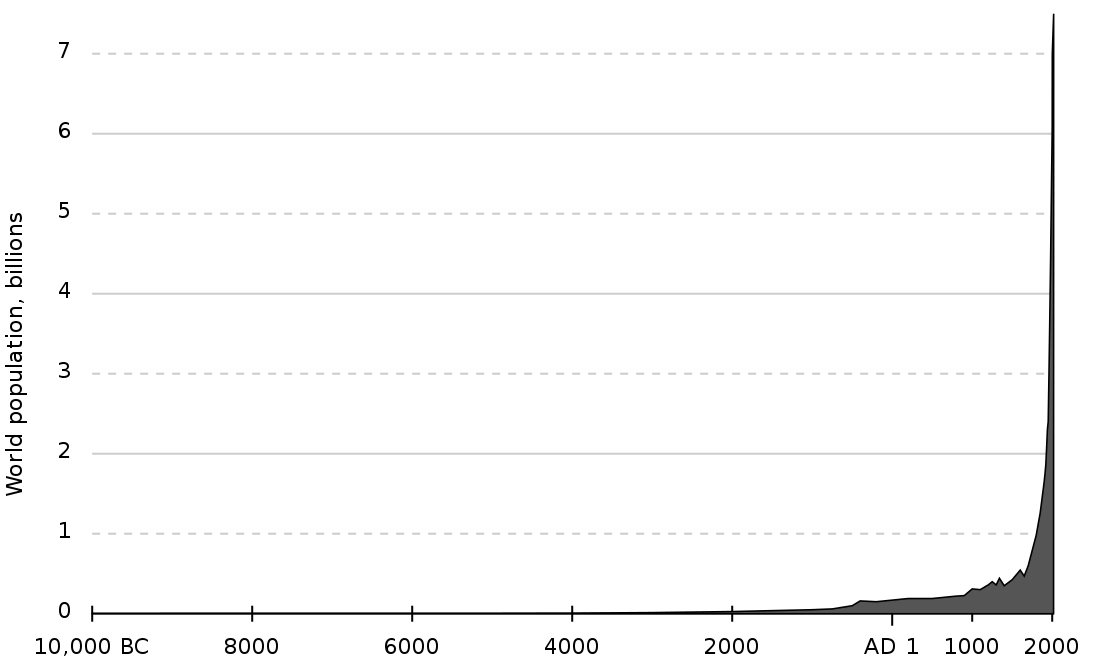CLIMATE CHANGE
FORMERLY GLOBAL WARMING
And prior to that... GLOBAL COOLING
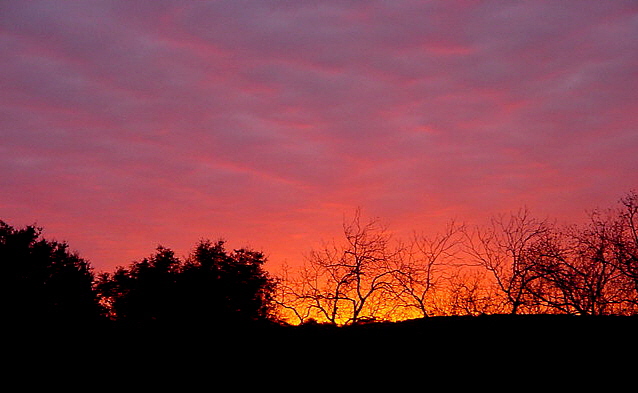
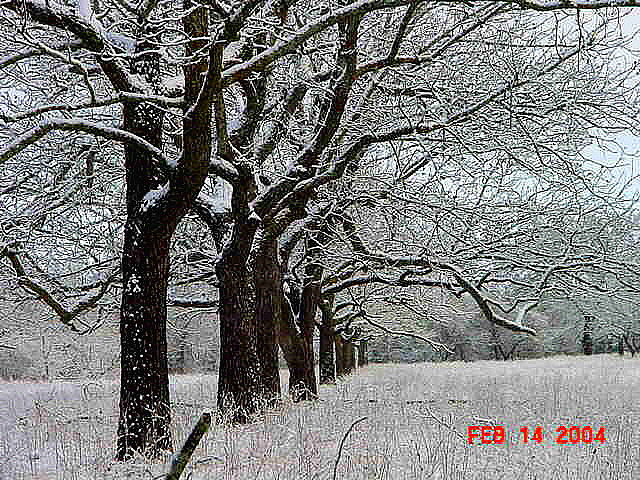
I remember in 1973 the media informed us that scientists confirmed all known and projected oil and gas reserves worldwide would last only 10 years... or if we were particularly careful we might make it 15 years. This "scientific fact" was repeated constantly on the radio, on TV, and in newspapers and magazines. They informed us that after that time there would be no oil and gas left in the entire world. Very alarming stuff! In response, governments reduced the speed limits to "help" (force) us to conserve. Prices sky rocketed. We were told that all leading scientists were in agreement on this "fact." It's easy to see in 2012 (and now) that they got it wrong!
Then, as early as 1975, we were warned about imminent global cooling (see The "Cooling World," Newsweek, April 28, 1975). In the 1980's, the media assured us that "leading scientists" were all in agreement that manufacturing produced gasses (ie. carbon dioxide) that were causing global cooling. (Naturally, WE were causing the cooling through manufacturing. No one seemed to consider natural fluctuation.) The media warned us that a return to the ice ages was imminent. Movies were made exploring global cooling and how it would affect us.
For a while I didn't hear much about pollution and its effect on global temperature. Time passed and again I started hearing about carbon dioxide causing the climate to change. But this time we were told that the carbon dioxide was causing global warming. Once again the "media" assured us that "leading scientists" were all in agreement. They had reached a consensus - global warming was the latest threat to the world. Of course, reaching a consensus is not following the scientific method. In a typical application of the scientific method, a researcher develops a hypothesis, tests it through various means, and then modifies the hypothesis on the basis of the outcome of the tests and experiments. In this way, hypotheses serve as tools by which scientists gather data.
With the media's ignorance regarding world-wide oil reserves and their switch from global cooling to global warming, I decided to look into global temperature change for myself!
First I looked over graphs depicting global temperatures. Some graphs covered only the last thousand years. Others covered 100's of millions of years. The first thing I realized is that we are currently in one of the earth's major ice ages (which began almost two million years ago). Prior to this ice age, the average global temperature was about 7 degrees Celsius warmer than it currently is today.
We live in what is called the Holocene interglacial, which is the seventh interglacial in our current ice age, the Quaternary. We live in Earth’s fourth or fifth ice age (there is some disagreement which). The current ice age is still relatively young – only about 2.58 million years old. The preceding ice ages differ in length between 30 million and 300 million years. The Holocene is, by some, considered the seventh interglacial of this current ice age. However, I've seen as many as twenty interglacials listed for this ice age. So it can be said that we are living in the seventh interglacial of the fourth ice age. The Holocene interglacial is only a tiny sliver of time compared to the 4.5 billion years of Earth’s existence. Without the warm climate of our Holocene interglacial there would be no history of human civilization to look back upon.

Surface temperature has not consistently risen at the rate predicted by simple greenhouse warming. While global temperatures have been relatively high over the past fifteen years, they have also been relatively stable. In addition, prior to assigning any temperature changes to man made causes, one must first subtract the changes produced by natural global temperature change mechanisms. I have not yet seen any assessment of natural global temperature change and no attempt to subtract the natural changes from the undefined supposed man-made global temperature changes! What is worse, when speaking about (now in 2019) climate change, all media outlets speak as if "climate change" is 100% man-made without any attempt to acknowledge that climate change has always occured as a natural phenomenon. Natural climate change cannot be controlled or altered; we can only try and adapt to the changes. It seems clear to me that "climate change" is yet another political agenda being used to control and manipulate the masses.
"Ice age" can mean two different things. It can refer to the four prolonged periods of generalized global cooling (as seen in the graph above) or perhaps more commonly, within an ice age it can refer to glaciations between the short warming periods called interglacials. This understanding helped me realize that the earlier "ice age" that "ended" about 10 thousand years ago was really part of a cycle of global cooling and warming within our current two million year ice age. While the earth warms withing the interglacials, the earth's temperature is always well below the "normal" temperature outside the ice ages. Therefore, even the hottest interglacial temperature is well below the earth's average non-ice age temperature.
Within our current period of generalized global cooling, glacials and interglacials occur at fairly regular repeated cycles. These cycles are controlled by predictable cyclic changes in Earth’s orbit. These changes affect the amount of sunlight reaching different parts of Earth’s surface. The three orbital variations are: (1) changes in Earth’s orbit around the Sun (eccentricity), (2) shifts in the tilt of Earth’s axis (obliquity), and (3) the wobbling motion of Earth’s axis (precession). It is important to note that in discussions of global warming/global cooling these three controlling factors are never taken into account or even mentioned. To me that is like ignoring the effect of your home heater when discussing the temperature inside the house!
During the present ice age, glaciers have advanced and retreated between 7 to 20 times, (depending on how the estimation was performed) often blanketing North America with ice. Our climate today is actually a warm interval between these many periods of glaciation. The most recent period of glaciation, which many people think of as the "Ice Age", was at its height approximately 20,000 years ago.
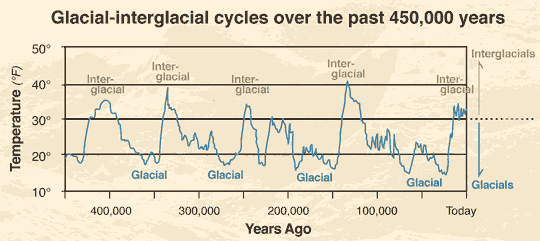
| The above graph combines several ice-core records from Antarctica and is modified
from several sources including Evidence for Warmer Interglacials in East Antarctic
Ice Cores, 2009, L.C. Sime and others. Note the temperatures, which are latitude-specific
(e.g., Antartica, Alaska, Greenland) temperature changes inferred from the Antarctic
ice cores (and not global averages).
In the Devils Hole, Nevada, paleoclimate record, the last four interglacials lasted over ~20,000 years with the warmest portion being a relatively stable period of 10,000 to 15,000 years duration. This is consistent with what is seen in the Vostok ice core from Antarctica and several records of sea level high periods. These data suggest that an equally long duration should be inferred for the current interglacial period as well. Work in progress on Devils Hole data for the period 60,000 to 5,000 years ago indicates that current interglacial temperature conditions may have already persisted for 17,000 years. So we seem to be relatively close to the end of this current interglacial and about to enter the glacial phase again! |
We are in one of the more than 20 warming cycles within the current two million year ice age. The warming cycles are called interglacials (between the glaciers). The scary thing to me is that we are nearing the end of the time frame for the interglacial warming period with the temperature ranges similar to those seen in the earlier interglacials of our current two million year ice age. That means that we are soon (soon in geological time) due for a cool down so that the temperature returns to ice age norms. The normal ice age temperatures are about four to five degrees Celcius cooler than our current temperature. (My guess is that this fact is what got the scientists predicting global cooling in the 1970's and early 1980's.)
As you can see in the following graph, the Eemian interglacial, the interglacial that occurred just before our present interglacial, was quite a bit warmer than our present interglacial and there was no "man-made global warming" back then. Also, the water temperature of the North Sea was about 2 degrees Celcius warmer than its current temperature. Why is this uncontested fact not mentioned when global warming is being discussed?
The Eemian interglacial period spanned 130,000–115,000 years ago. Sea level at its peak was probably 6 to 9 metres (20 to 30 feet) higher than it is today.
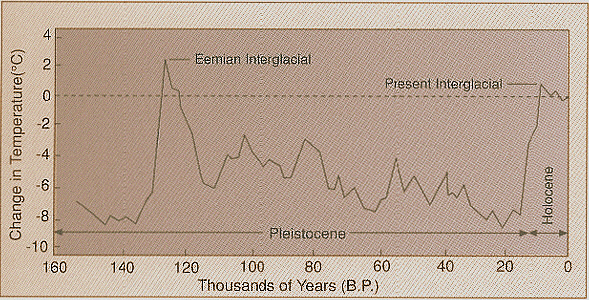
Of couse, we could get even warmer for a while longer before the cool down, or we might be coming out of the ice age altogether. In that case the earth will be getting much much warmer! Sadly, the earth's average temperature has been much much warmer for more than half of its existance so this great increase in temperature is a possibility.
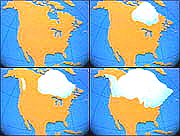 RECAP: The Holocene Interglacial is our most recent period between glaciations. The
period of receding glaciation preceding the Holocene Interglacial is the Eemian Interglacial,
which began 130 thousand years BP (Before Present). The warmest temperature in the Eemian
Interglacial was 1 to 2 degrees Centigrade higher than our current Holocene Interglacial
temperature (1 to 2 degrees warmer than now). During the Eemian Stage sea level
was about 8 meters (24 feet) higher than today and the water temperature of the North Sea
was 2°C higher than at present. The Eemian Interglacial lasted about 16,000 years.
We certainly didn't cause the global warming of the Eemian!
RECAP: The Holocene Interglacial is our most recent period between glaciations. The
period of receding glaciation preceding the Holocene Interglacial is the Eemian Interglacial,
which began 130 thousand years BP (Before Present). The warmest temperature in the Eemian
Interglacial was 1 to 2 degrees Centigrade higher than our current Holocene Interglacial
temperature (1 to 2 degrees warmer than now). During the Eemian Stage sea level
was about 8 meters (24 feet) higher than today and the water temperature of the North Sea
was 2°C higher than at present. The Eemian Interglacial lasted about 16,000 years.
We certainly didn't cause the global warming of the Eemian!
The four pictures show the progression of glaciation. At the height of the Eemian there is virtually no glaciation. As the temperature dropped, glaciation increased. During the glaciation period prior to the Eemian the glacier was determined to be 1,000 feet thick and progressed as far south as the Northeastern corner of Kansas!
Melting ice from Antarctica was determined to be the main driver of sea level rise in the last interglacial period, which lasted about 10,000 years (a bit less time than this current interglacial has lasted!). Also in the last interglacial (about 125,000 to 118,000 years ago) temperatures were up several degrees F higher than today's temperatures. In addition, ice melt caused global seas to rise about 30 feet above the present level. The ice melted first in Antarctica, then a few thousand years later in Greenland. Sea levels rose at up to 9 feet per century, far exceeding the roughly 1 foot rise claimed by some over the past 150 years.
This early ice loss in Antarctica occurred when the Southern Ocean warmed at the start of the interglacial. The meltwater changed the way Earth’s oceans circulated, which caused warming in the northern polar region and triggered ice melt in Greenland. The last interglacial is not a perfect scenario for the future. The Earth's position relative to the Sun (the main driver of earth's temperature changes) affects the level of incoming solar radiation and the earth's overall temperature.
Warming interglacials have lasted, on average, about ten thousand years before the world's temperature returns to a colder climate. The current interglacial is the holocene interglacial. The holocene interglacial has already lasted at least ten thousand years.
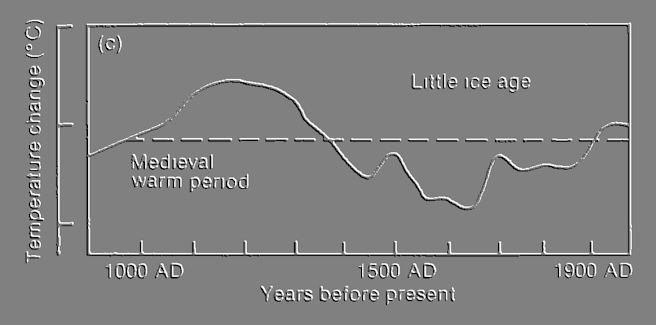
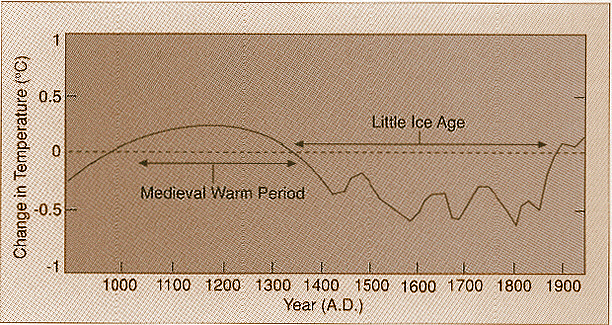
You will note that the earth's present temperature is in the range of earth's temperature during 1000 AD to 1350 AD. I've never heard this fact mentioned in media reports? Until recently, temperature changes clearly had nothing to do with man made factors. Therefore, any valid discussion of man made contributions to temperature change MUST include a discussion of the natural and cyclic factors involved in world wide temperature change and the factors contributing to those natural temperature changes. So far a discussion in these natural factors has been completely absent, making me question the scientific reliability of all of these so called "scientific" global warming facts!
The maximum cold in the preceding glacial period was approximately 23,000 to 15,000 years ago with ice caps approximately one mile thick and the sea level about 350 feet below present levels. A specific example is that covering the area of New York (and much much more) was a glacial cap one mile thick. Also, there was a worldwide increase in atmospheric dust.
Recent paleodata have revealed that there were abrupt transitions in climate in which major shifts in some components of the earth's climate are accomplished on time scales of a decade or less! Greenland ice cores suggest changes took place in between five to ten years!
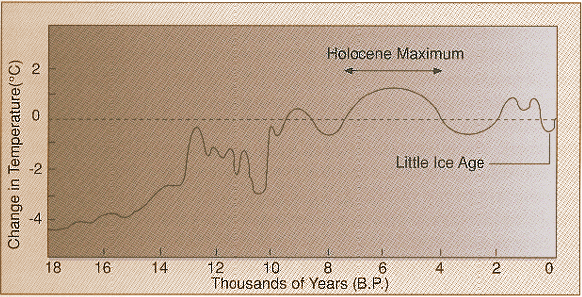
You can see in the graph, above, that the temperature 18,000 years ago (at the beginning of the Holocene Interglacial) was about four degrees Centigrade colder than our current average temperature. Note that somewhere between 18,000 and 14,000 years ago the last "ice age" (glaciation) was ending and we were entering our current interglacial period. You can see that, as always, the temperature fluctuates throughout its cycle, both rising and falling!
See the abrupt drop in temperature at about 10,500 Before Present and the abrupt rise in temperature about 10,000 Before Present. The rise was about 2 1/2 degrees Celcius in a very few years and the drop was abrupt and significant. The amount of change in the last 100 years is negligible compared to the natural change seen then!
We can see that the temperature exceeded current levels not only between 750 - 2000 years before present but also 4,000 - 7000 years ago and 8,500 to 9,500 years ago.years! We cannot credit man made global warming for ANY of those time periods in which the earth's temperature exceeded current levels! Of course, the higher temperature of the past are not included in discussions of man-made global warming (Now designated climate change, since you can argue that global warming isn't "man-made" but who can argue that there isn't climate change? The climate always changes! If you believe in man-made global warming don't change the words to something else! Say Man-Made Global Warming! Otherwise, it seems like you know there is a problem with your position!)
Other sources have time frames for the warming and cooling periods in the Holocene that, while similar in overall pattern, vary a bit on the exact dates. The closer to the present we come the greater all sources are in agreement. For example, from the Roman period continuing to the present, climate intervals are stated as residing near the following dates:
The Roman Warming (250 BC—450 AD)
The Dark Ages (535–900 AD)
The Medieval Warming (900–1300 AD)
The Little Ice Age (1280–1850 AD)
The Late 20th Century Warming (1850 AD to the present)
These sources state that during both the Roman Warming and the Medieval Warming, global temperatures were actually higher than current global temperatures. They also note that during both the Dark Ages and the Little Ice Age, global temperatures were lower than they are currently. (I've never seen or heard an advocate of man made global warming discuss these rather dramatic world wide temperature fluctuations and how the contribution of earth's natural temperature fluctuations were removed from the calculation to determine that man is dramatically affecting our current world wide temperature! No assertion that world wide temperature changes are caused by man can be considered valid until the mechanism by which natural fluctuation was removed from the equation has been clearly provided and proven reliable.)
They also note that during the Late 20th Century Warming, the Earth's temperature began to recover (rise) from the long “Little Ice Age.” Of course, this period wasn’t actually an ice age. It was a less warm period during the current interglacial.
Many who support the idea that the earth is warming say this is due to increasing levels of CO2 in the atmosphere. During the last period of glaciation the atmospheric CO2 content was much lower than today, about 190 ppmv. By the beginning of the Holocene, atmospheric CO2 had risen to approximately 250 ppmv. In the last 8,000 years atmospheric CO2 increased to its current 391 ppmv. Although Global temperatures during the Roman Warming were higher than today, the atmospheric CO2 content was lower. This fact alone disproves the claim of man-made global warming advocates who claim that CO2 is the main climate driver.
Global Warming is now called Global Temperature Change, which is a safer designation because global temperature ALWAYS changes. However, I have yet to see a Global Warming prediction (Global Temperature Change prediction) that includes an explanation of how NATURAL GLOBAL TEMPERATURE FLUCTUATIONS were taken into account AND ELIMINATED WHEN MAKING THE GLOBAL TEMPERATURE CHANGE PREDICTION!
Any valid assertions regarding MAN MADE TEMPERATURE CHANGES must include the method used to take into account and eliminate natural global temperature fluctuations! Assertions that the changes are MAN MADE that don't contain information about the method they used to eliminate natural global temperature fluctuations are not valid and lack scientific credibility!
Why is so much time, energy, and money being spent trying to prove that global warming is Man Made without any of the studies actually using the scientific method to do so? Perhaps the answer is in the question? "Money!" Maybe if we followed the money (as they say) the money trail would lead us to the answer!
